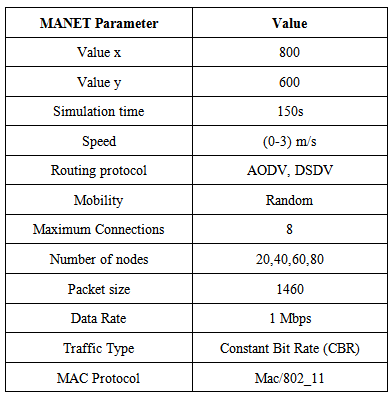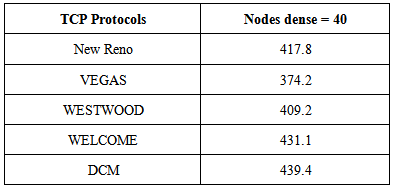-
Paper Information
- Paper Submission
-
Journal Information
- About This Journal
- Editorial Board
- Current Issue
- Archive
- Author Guidelines
- Contact Us
Journal of Wireless Networking and Communications
p-ISSN: 2167-7328 e-ISSN: 2167-7336
2014; 4(3): 67-75
doi:10.5923/j.jwnc.20140403.01
Protocol for Dynamic Avoiding End-to-End Congestion in MANETs
Rushdi A. Hamamreh, Mohammed J. Bawatna
Computer Engineering Department, Al-Quds University, Jerusalem, Palestine
Correspondence to: Rushdi A. Hamamreh, Computer Engineering Department, Al-Quds University, Jerusalem, Palestine.
| Email: |  |
Copyright © 2014 Scientific & Academic Publishing. All Rights Reserved.
In mobile ad hoc networks (MANETs), congestion can occur due to limitation in resources and lead to high packet loss, long delay and waste of resource utilization time. The major objective of congestion control is to best utilize the available network resources by keeping the load below the capacity. The great demand for capacity, place particular emphasis on congestion management approaches.Recently, researchers have developed many effective and well studied algorithms for congestion control within Transmission Control Protocol (TCP) to improve its performance over MANET environment. TCP is designed to be reliable and ensure end to end delivery in wired network. However, each existing TCP variant over MANET has its weaknesses and strengths when changing MANET factors like: node mobility, traffic loads, network size and wireless channel conditions. In this paper a new approach to decrease packet loss using dynamic path congestion estimation. The simulation results show an improvement in TCP performance over MANET in different scenarios.
Keywords: TCP-VEGAS, TCP-WESTWOOD, TCP-WELCOME, TCP-DCM, MANET, Congestion, Link failure, Signal loss, RTO
Cite this paper: Rushdi A. Hamamreh, Mohammed J. Bawatna, Protocol for Dynamic Avoiding End-to-End Congestion in MANETs, Journal of Wireless Networking and Communications, Vol. 4 No. 3, 2014, pp. 67-75. doi: 10.5923/j.jwnc.20140403.01.
Article Outline
1. Introduction
- The transmission control protocol (TCP) is the most predominant transport layer protocol in the Internet today. It is a reliable, end to end, connection oriented transport layer protocol that is split into segments. The major functions of TCP include congestion control, flow control, in order delivery of packets and reliable transportation of packets. Congestion control handles the overflow traffic in the network which leads to degradation in the performance of the network. TCP manages the number of packets sent to the network by increasing and decreasing the congestion window (CWND). The TCP sender starts the session with a congestion window value of one MSS.The major function of Congestion Window (CWND) is to limit how much data allowed having in transit at a given time. The congestion window is congestion control‘s counterpart to flow control‘s advertised window that is received from the destination. TCP is modified such that the maximum number of bytes of unacknowledged data allowed is now the minimum of the congestion window and the advertised window [1].
 | (1) |
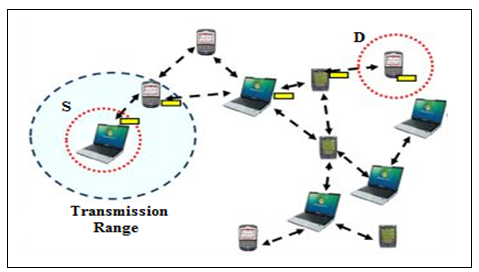 | Figure 1. Mobile Ad Hoc Network (MANET) |
2. Related Work
2.1. Existing TCP Variants
- There are several variants of TCP implemented to solve the problems over MANET. In this paper I will focus on four main variants: TCP New Reno, TCP VEGAS, TCP WESTWOOD, and TCP WELCOME.
2.1.1. TCP NEW RENO
- TCP New Reno is an effective modification of the original congestion avoidance algorithm in TCP RENO. The modification is an improvement of the Fast Recovery phase. CWND is modified as the following,
 | (2) |
 | (3) |
 | (4) |
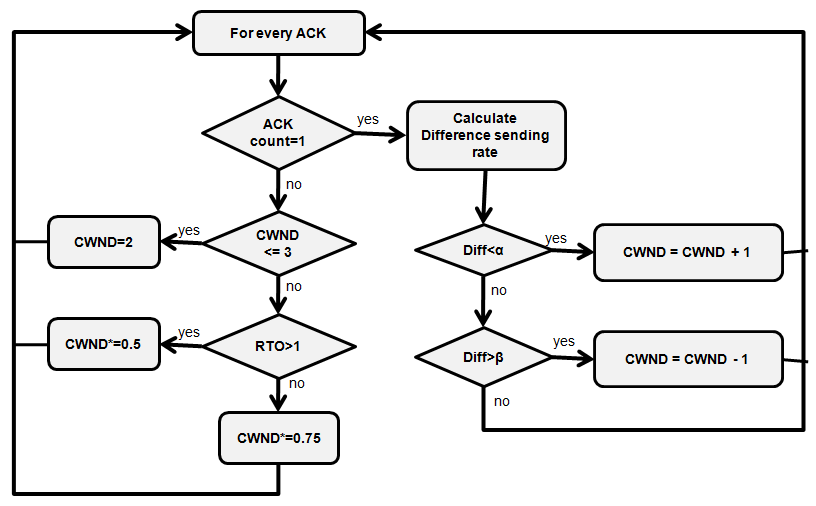 | Figure 2. The flowchart for congestion control in TCP-VEGAS |
2.1.2. TCP-VEGAS
- Vegas is an enhancement of RENO. It depends on proactive measure to encounter congestion in much more efficient than reactive ones. It overcomes the problem of requiring enough duplicate ACKs to detect a packet loss, and it suggests a modified slow start algorithm which prevents it from congesting the network [6].The new retransmission mechanism in Vegas extends on the retransmission mechanism of RENO. It keeps track by calculates an estimate of the RTT. TCP Vegas is different from all the other implementation in its behavior during congestion avoidance. It determines congestion by a decrease in sending rate as compared to the expected rate as the following:When new Ack is received,
 | (5) |
 | (6) |
 | (7) |
 | (8) |
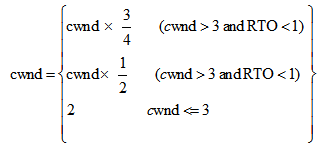 | (9) |
2.1.3. TCP-WESTWOOD
- TCP-Westwood uses bandwidth estimation to achieve protocol performance in mixed wired and wireless networks as following,When new ACK reception, Congestion Window (CWND) is increased accordingly to the Reno algorithm; the end-to-end bandwidth estimate BWE is computed; [8].
 | (10) |
 | (11) |
2.1.4. TCP-WELCOME
- TCP Wireless Environment, Link losses, and Congestion packet loss ModEls (WELCOME) [9] is a sender side based solution that improves the TCP performance by its ability to differentiate between causes of packet loss and then triggers the most appropriate packet loss recovery algorithm according to the identified loss cause. Process in this TCP variant consists of two phases:Phase-1: Loss Differentiation Algorithm (LDA). In this phase, causes of packet loss are identified accurately during the data transmission. Packet loss causes in MANET: 1. Wireless Channel caused by several factors like: Signal Fading, Interference, Obstacles and environment effects2. Link Failure caused by several factors like: Mobility, battery and obstacles 3. Congestion occurs at nodes buffer.As in the following figure:
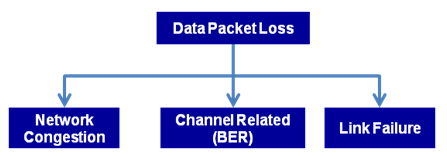 | Figure 3. Types of packet losses |
 | (12) |
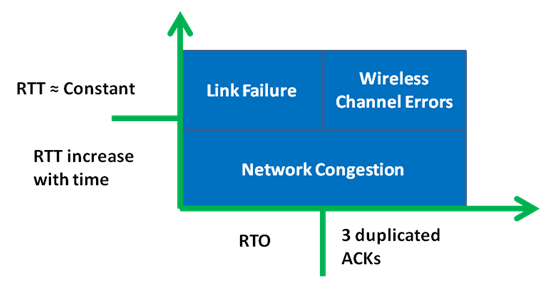 | Figure 4. TCP WELCOME loss differentiation based on RTT, RTO and 3 duplicated Ack |
 | (13) |
 | (14) |
2.2. MANETs Routing Protocols
- Routing protocols are classified into three categories: Proactive, Reactive and Hybrid. Table Driven (Proactive): In this type the routes to all destinations are determined at the start up and maintained by using a periodic route update process. The Advantage of this type is that routes always available. The Disadvantage of this type is the very high control overhead needed to maintain all routes.Source Initiated (Reactive) [10]: In this type the route is determined only when it is required by the source, and it is maintained as long as it is needed. The Advantage of this type is the low control overhead needed since it is on demand. The Disadvantage of this type is the high initial delay needed to discover the route to destination. In this paper we will focus our work in AODV protocol as one of MANET routing reactive protocols. AODV is a reactive routing protocol that uses next hop routing approach. Each node maintains a single path to a destination. AODV consists of two routing operations: Path discovery process and Path maintenance process. Every node maintains two separate counters: Sequence Number and Broadcast ID.Source node starts path discovery by broadcasting a route request (RREQ) packet to its neighbors, which includes source address; source sequence number; broadcast id; destination address; destination sequence number; and hop count. If the receiving node is an intermediate node with valid route to destination, it will send back a route reply (RREP) using the reverse path only if RREQ’s sequence number is smaller than that recorded in the intermediate node, or sequence numbers are equal with smaller hop count in the intermediate node. Otherwise the intermediate node will rebroadcast the RREQ.If the receiving node is the destination node itself, it will send back a RREP using the reverse path. A RREP contains the following information: source address, destination address, destination sequence number, hop count, and lifetime. AODV stores only one route per destination with a certain life time. Once a route is established, it must be maintained as long as the route expiration time does not expire. This is done by exchanging “hello” packets periodically [11].
3. Problem Definition
- The problem of TCP over Mobile Ad Hoc Network is applying congestion control algorithm to types of packet losses that are not lost due to congestion. When a packet is detected to be lost, either by timeout or by duplicated ACKs, TCP decrease the sending rate by adjusting its congestion window (CWND). In wireless network bit error rates are very high things that cause packet losses due to physical channel. Another factor that exist in MANET is the dynamic topology due to node mobility, things that case packet loss from link failure till find new route. These kinds of packet loses are misjudged by TCP and treated as congestion, things that cause TCP performance degradation.Many approaches use Round Trip Time (RTT) and Bandwidth (BW) estimation, but none of them work perfect in all scenarios without any problems. TCP WELCOME performs much better than other variants over MANET, because its ability to differentiate between different types of packet losses, However it apply the traditional congestion algorithm in TCP-New RENO. In this paper, a new technique of congestion avoidance is proposed to replace the traditional congestion algorithm of TCP-NEWRENO.
4. Proposal for Solution
- TCP-Welcome success to identify causes of packet losses as a key solution to the problems of TCP over MANET, However it has a weakness of applying conventional mechanism used by TCP-NewRENO of congestion control. To solve this problem, we now present our proposed Dynamic end-to-end Congestion detection protocol for MANET (TCP-DCM), a new cross layer solution that uses the results of route request process from routing protocol to early detect the end-to-end congestion, and dynamically select the path with minimum congestion from source to destination. As mentioned in section II.2, during route request process, sender initiate a Route Request message to one hop nodes surrounding it. The process remains until this message receives the destination. After that destination select the shortest path and generate a Route Reply message to sender. Other valid paths from source to destination will be discarded.Our modification has two phases: one on the destination node before generating Route Reply message and the other at sender side during the connection.In first phase, destination will select three valid paths (if possible) which have the minimum cost, and send them to source node through Route Reply message.In second phase, source will measure Round Trip time (RTT) under the control of TCP. After that source will select the minimum RTT path as main path from source to destination.During communication, if TCP detect gradual increase in RTT greater than congestion threshold level (CONGESTION_THREHOLD) as in equation (15), TCP will notify the network layer to check the validity of other paths available at source. If source found another path with lower RTT than current path, it will notify network layer to select that path for communication.
 | (15) |
 | (16) |
 | (17) |
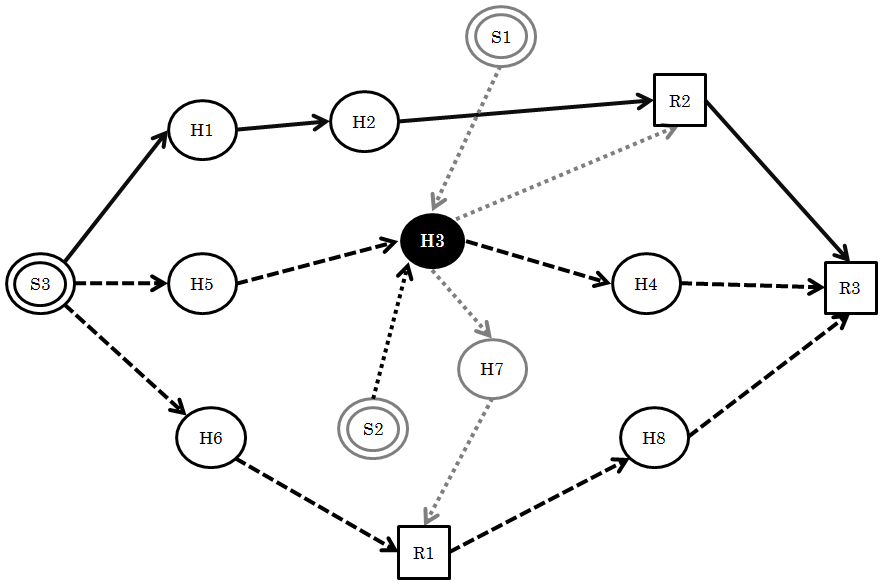 | Figure 5. Ad hoc network with three TCP connections |
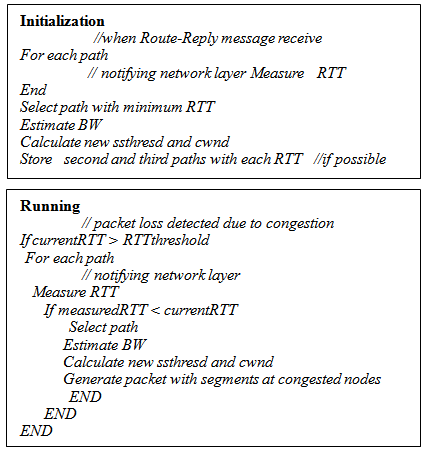
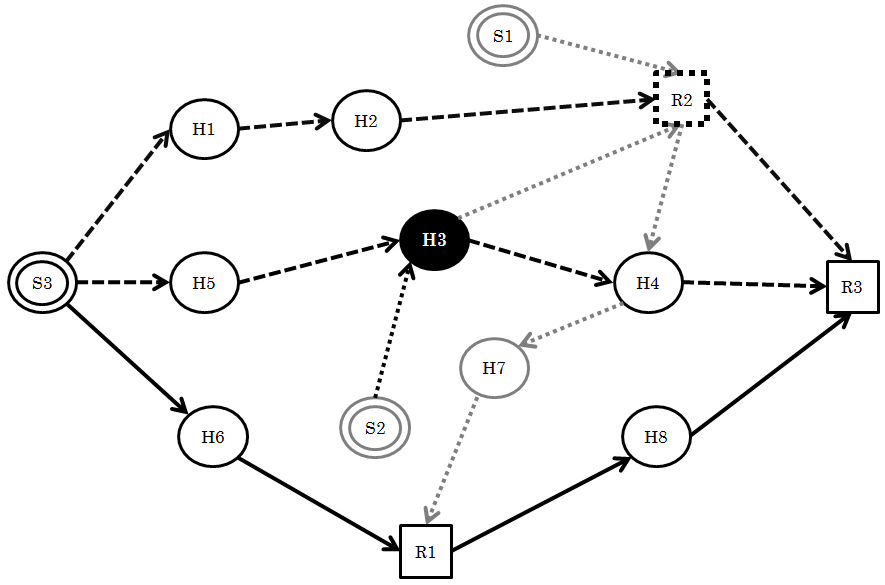 | Figure 6. Ad hoc network with three TCP connections |
5. Tools, Validation Model and Simulation Environment
- Simulation can carry out experiments without the actual hardware and provides a good compromise between complexity and accuracy [14]. In this section I will present the performance metrics used in validation, simulation tools and experimental results.
5.1. Performance Metric
- In order to evaluate algorithm effects on TCP performance, the following metrics must be considered: 1. Packet Delivery Fraction [17]: It is the ratio of the number of packets received successfully and the total number of packets sent.
 | (18) |
 | (19) |
 | (20) |
5.2. Simulation Tools
- The proposed algorithm has been implemented and evaluated over NS 2 simulator which is discrete event simulator. NS 2 is written in C++, which is object oriented language. NS2 support simulation of different variant TCP and different routing protocols over wired and wireless networks.
|
|
|
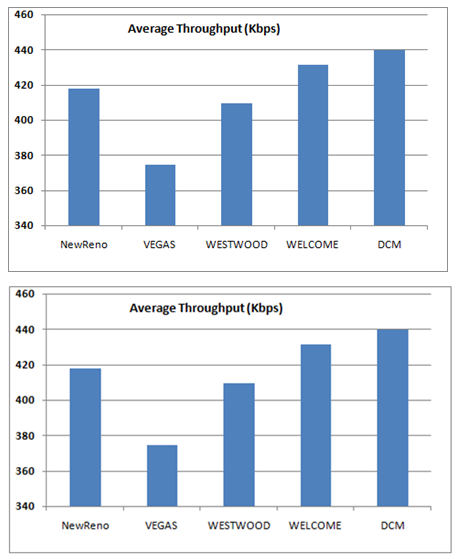 | Figure 7. Average throughput (Kbps) for 40 nodes |
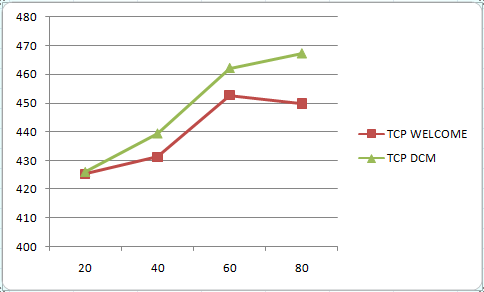 | Figure 8. Average throughput (Kbps) for 20,40,60,80 nodes |
6. Conclusions
- This paper presents current research on solving TCP congestion problems over MANET by presenting most used TCP variants that preserve end to end semantic and there analysis to increase performance of TCP over MANET. As in case of mobile networks, performance of TCP degrades because of its inability to handle efficiently packet losses due to congestion. We have placed special emphasis on TCP-WELCOME, because it is the most successful TCP variant over MANET, due to its ability to differentiate between types of packet losses in MANET. This article proposed a new dynamic mechanism to replace traditional congestion algorithm of TCP-NewReno used in TCP-WELCOME with dynamic minimum congestion path selection through cross layer analysis. With reference to data analysis and the experimental results, it shows that, TCP-DCM handles packet losses problem due to congestion in more efficient way than TCP-WELCOME does. Hence it improves overall throughput and increase TCP performance over MANET.
 Abstract
Abstract Reference
Reference Full-Text PDF
Full-Text PDF Full-text HTML
Full-text HTML